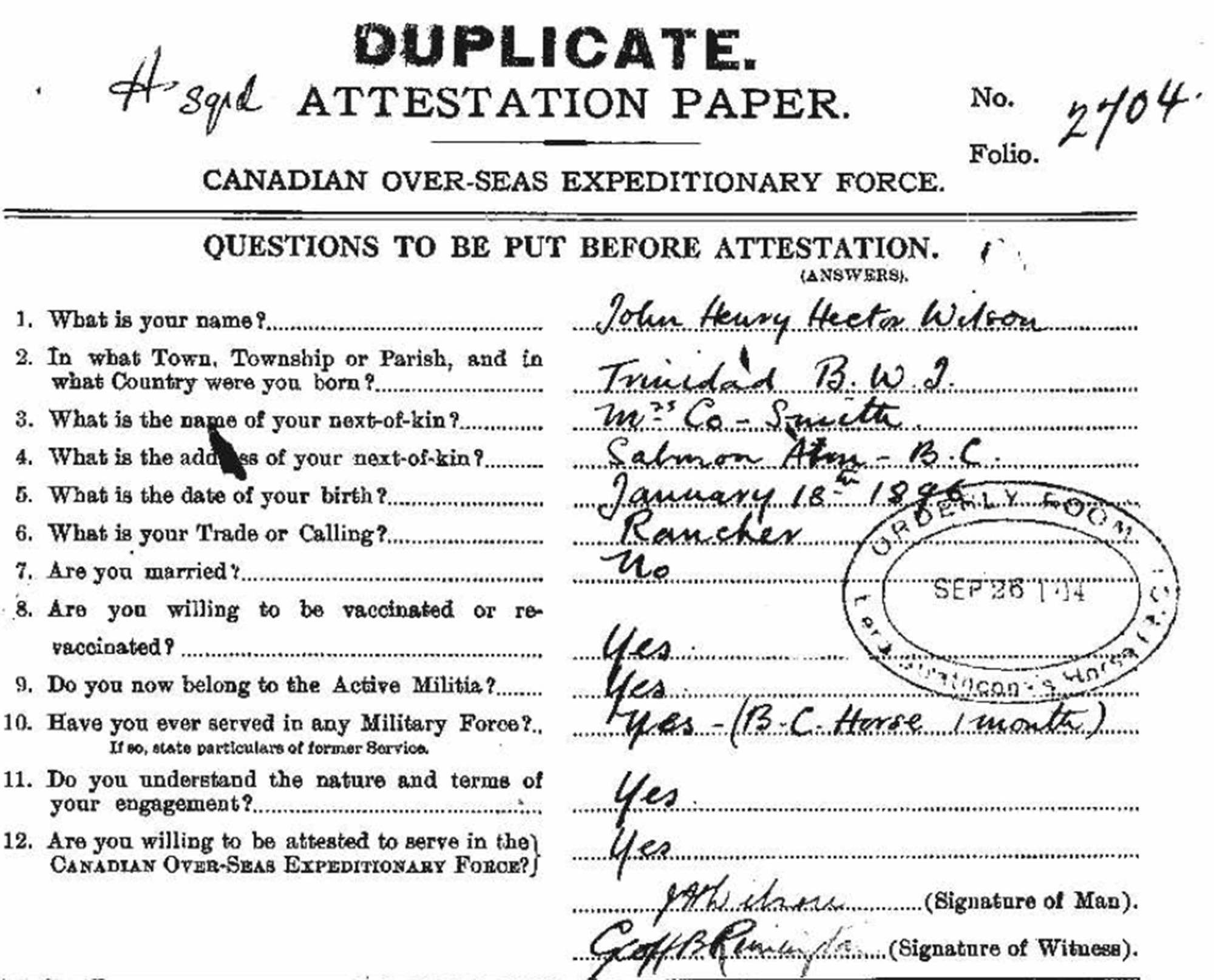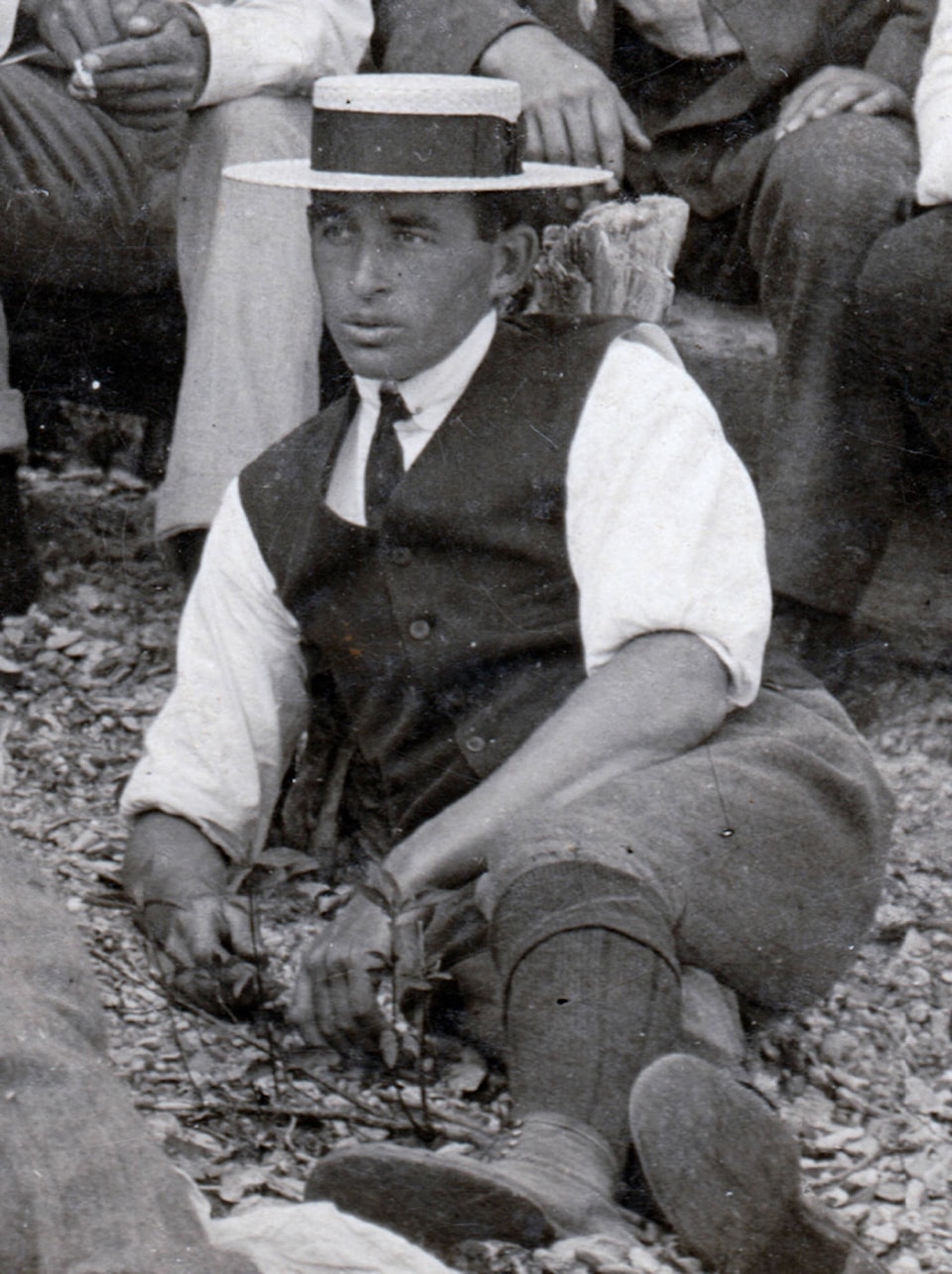By Cindy Kilpatrick
Contributor
Born Jan. 18, 1897, John Henry Hector Wilson (Great Uncle Hector) was the fifth of eight children born to George Hector Wilson and Rosa Charlotte Mary (nee Cadiz) Wilson of #8 Marli Street in Port of Spain, Trinidad.
Hector’s father, a Port of Spain businessman, became ill when Hector was young and could no longer support the family. In 1910, his eldest sister Milly travelled to Salmon Arm to work for a family friend as an au pair to their children. She was 20 at the time and her 16-year-old brother, Charlie, travelled with her. Hector followed in May of 1912, at age 15, with their 16-year-old sister, Evelyn.
The boys found work on the farms and orchards around Salmon Arm.
When the First World War was declared on Aug. 5, 1914, the British Columbia Horse, a militia cavalry regiment based in Vernon and Nicola Lake south of Kamloops, prepared to go into active service. Hector, now 17, joined up and trained with them.
Hector no doubt enjoyed the cheers and boxes of apples that met the train carrying his regiment and their horses as it passed through Salmon Arm on Aug. 27 on its way to Valcartier.
Still half a year away from his 18th birthday, he was too young to enlist. Perhaps his siblings, who were likely among the crowd at Salmon Arm, thought he would be sent back home.
When they arrived at Valcartier, the regiment was informed they were to be disbanded and their members would be absorbed into other units.
Hector, along with other determined riders, including his commanding officer, Charles Flick, enlisted with Lord Strathcona’s Horse. He lied on his form, dated Sept. 22, 1914, giving his birth year as 1896, allowing him to qualify for enlistment.

Eight days later, the regiment rode through darkness, rain and mud to Quebec City, singing along to the regimental band playing, It’s A Long Road To Tipperary.
Little did they know the conditions of that first ride as a regiment would be the first of many rides they would endure over the next four years.
At Quebec, they waited their turn to embark on their ship, the SS Bermudian, to England. The Bermudian was one of 32 transports escorted by seven warships that made up the Grand Fleet of the Canadian Expeditionary Force, which would carry nearly 30,000 soldiers and equipment across the Atlantic. The Bermudian cast anchor on September 30th.
Originally bound for Southampton, the fleet was redirected to Plymouth due to concerns there were U-Boats, enemy submarines, in the area. Although unprepared, on October 14, 1914, the people of Plymouth turned out in cheering crowds to welcome this first contingent of Canadians.
The weather was beautiful the day they arrived at their camp, but rain began the very next day and didn’t let up for three months. Hector’s service record shows he remained healthy while many of the men became ill from various maladies, including an outbreak of viral meningitis.
The horses suffered as well, knee-deep in mud and shivering for much of the time.
The men trained and slept under canvas until finally, in January, they gratefully moved to billets in nearby towns. Then in March the regiment moved to Maresfield Camp in Sussex and began predeployment intensive training which included dismounted infantry skills.
After half a year of training in the mud, no doubt spring found the troops restless and impatient. This might explain Hector’s first field punishment, which was recorded on April 19th, 1915 at Maresfield for refusing to obey an order
He was docked seven-days’ pay and, according to the WarMuseum.ca, would have been assigned extra labour duties as well.
On May 4, 1915, the regiment boarded the SS Onward at Folkstone, without their horses. The need for infantry was dire and cavalry not so much, so the men would serve dismounted to support their comrades.
They arrived in Boulogne, a port in northwest France around midnight, then marched three miles to camp. They first came under fire on May 22, 1915, at Festubert. They fought at Givenchy in June and were subsequently transferred to the line at Messines, where they remained until January 1916.

Technological changes during the war caused leadership to constantly rethink the best means of exploiting the skills and manpower of the cavalry.
In February 1916, the regiment’s horses were shipped over from England. Mounted training took place through winter and spring before the regiment was sent to the Somme front in June.
There they served in support of the infantry, building trenches and roads, and doing reconnaissance, but prepared to move forward on little notice.
In March 1917, the regiment had gained recognition for their part in the pursuit of the enemy, retreating to the Hindenburg Line on the Somme front. Training behind the lines resumed in July and continued until Nov. 8, when Hector moved forward with his regiment to prepare for the Battle of Cambrai, known as the first major use of tanks in battle.
The army engaged on Nov. 20 and had some success that day. They mowed over the German Hindenburg Line but were unprepared for, and slow to respond to, the strength of the German counterattack.
Mounted and ready to push through the anticipated break in the German line, the cavalry was eventually sent back to their camp after the army failed to achieve their objective.
On Nov. 27, they were moved further back to make winter camp at Montecourt.
Suddenly, at 9:30 in the morning on Nov. 30, while the men were on exercise, orders were received to return to the front immediately. The enemy had counterattacked and recaptured ground that the allies had taken 10 days earlier.
By 11:45 a.m., Lord Strathcona’s Horse were at the rendezvous point and commenced a mounted march to Villers Faucon.
After riding more than 20 kilometres, they moved into line between the Royal Canadian Dragoons and the Ambala Brigade that night.

At 3:15 in the afternoon on Dec. 1, Hector’s squadron came under heavy machine gun and artillery fire in their attempt to seize the road between Gauche Wood and Villers Guislain. Fourteen men were killed and eight wounded, including Hector. He suffered a gunshot wound to the head, causing a compound fracture to his skull.
Six days later, he was transferred to the #10 General Hospital at Rouen, miraculously surviving what was likely a grueling train trip.
Unfortunately, two days later he died of his injuries. It was Dec. 9, 1917, as Hector was just short of his 21st birthday. He is buried in the Saint Sever Cemetery Extension, Rouen, France.
His grave number is P.V.0. 12A, and the inscription on his cross says, “At Rest.”
His name is inscribed on the cenotaphs in Salmon Arm and Port of Spain, Trinidad and Tobago.
Great-Uncle Hector, you are not forgotten.
Read more: Salmon Arm man’s annual Remembrance Day trail work a tribute to veterans
Read more: Fearless allies: Shuswap woman reflects on childhood in Dutch Resistance
